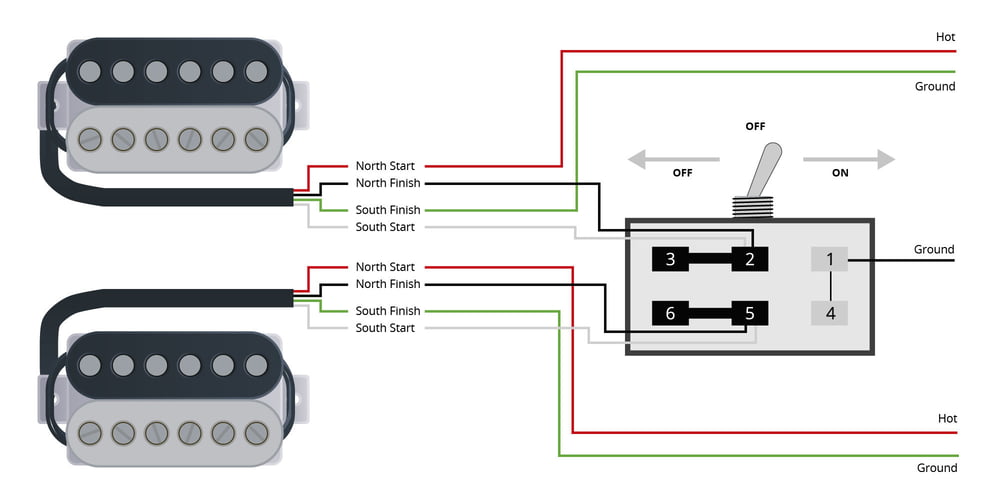10. Dual Sound
To summarize, you can wire the coils of a humbucker in two ways: Serially for the full power sound and parallel for the more transparent, cleaner one. And to reiterate, wiring them in parallel does not cause them to become out of phase. The humbuckers will work as previously stated, cancelling out interference, but will sound like two single coils.
By using a mini-switch (2-pole switch, DPDT for example DiMarzio EP1106) or a push-pull potentiometer (for example DiMarzio EP1200PP or EP2001PP) both wiring principles can be used and the tonal flexibility of the guitar is greatly increased.
The wiring looks like this:
For the circuit to work, be sure to wire the jumper connection (bridge) between the poles. The hot output is soldered to the point where the pickup's hot cable was originally connected. The earth outlet is connected to a ground.
To rotate the phase you need to swap the hot output and the ground connection. The ground cable of the pickup remains grounded in both variants.
Dual-Sound with a single-coil switch
To create this circuit you just need to replace one switch with a 2-pin on-on-on switch (DPDT on/on/on, for example DiMarzio EP1108). The wiring is the same as in the diagram above. But now the two outer switch positions provide the parallel or serial circuit. In the middle position you'll get a single coil sound!
Phase-switch
A phase switch can only be done on guitars with at least two pickups. The 'out-of-phase' effect only works if both pickups are active at the same time and if the volume of both sound generators is at around the same level. To make 'out-of-phase' switchable all you need to do is connect one of the two pickups to a 2-pole switch (DPDT, the same as with dual-sound, ex: EP1106 or Push-Pull Poti EP1200PP or EP1201PP). Which of the two pickups you use makes no difference for the sound. So decide for yourself!
If you want to connect the pickup to a dual switch and a phase switch at the same time, start wiring the dual switch as described and then connect it to the phase switch as shown in the following diagram:
The output marked 'hot' is connected to the point where the original pickup was connected. The ground labeled pole is connected to ground (usually the back of a pot). The same applies to the grounding cable of the pickup (4-core version).
Single Coil Switch (Coil-Splitting, Coil-Tapping)
Single coils go with guitar music like butter on toast (or something like that). And as mentioned, you don't need to forgo the crisp and open sound of a single coil on a 'humbucker guitar' if you don't want to.
To set up the coil splitting function on its own mini-switch you'll need a 2-pole switch (DPDT, on/off/on) or a simple single pole switch (double throw, SPDT). The schematic below shows the wiring of a 2-pole DPDT switch.
The ground cable of the pickup must be connected to ground on the switch. Since only one side of the switch is used it is possible to use the other side to turn make your second humbucker sound like a single could. The wiring for that looks like this:
If you want to combine a phase switcher with a coil split switch then use the following wiring set-up:
What's interesting with this wiring is that the phase switch takes over two functions at once. When both pickups are active it does its normal job of phase switching. However, if only one connected pickup powered and at the same time the coil split function is active, then the phase switch determines which of the two coils of the humbucker is switched off. The change in the sound is very subtle but hey! It's another option.









